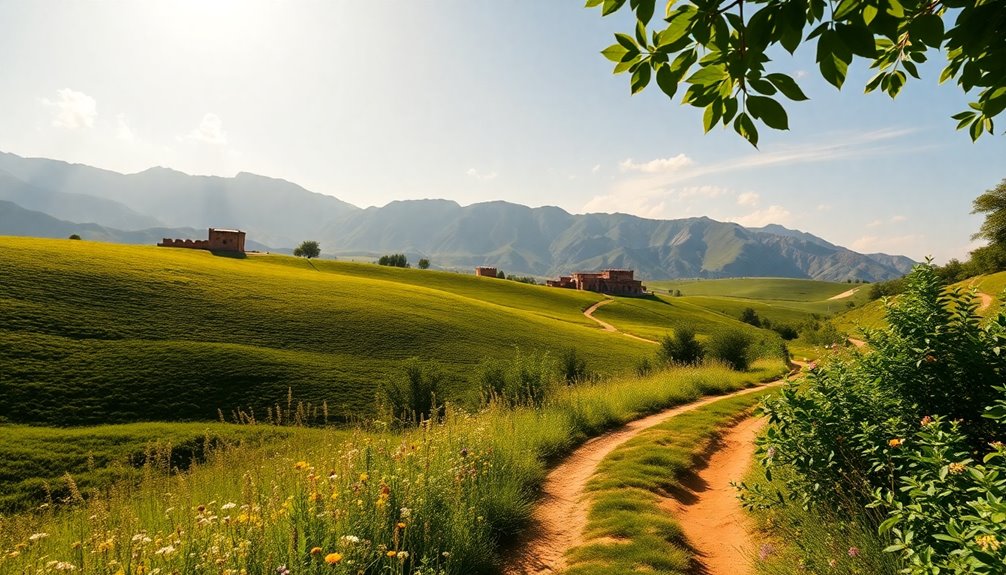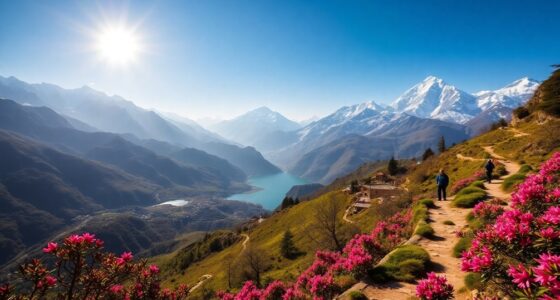Uzbekistan's Green Tourism Route along the Silk Road invites you to explore its rich heritage while embracing eco-friendly practices. You'll travel from Tashkent to the historical wonders of Samarkand and Bukhara on high-speed trains or scenic buses. Enjoy sustainable wildlife tours, partake in artisan workshops, and discover local crafts that support traditional methods. The vibrant landscapes in spring and autumn enhance your journey, with opportunities for community engagement and conservation efforts. As you immerse yourself in this unique experience, you'll uncover even more insights and adventures that await along this ancient route.
Key Takeaways
- Uzbekistan's Green Tourism Route highlights eco-friendly travel experiences, promoting conservation and sustainable practices along the historic Silk Road.
- Key cities like Samarkand, Bukhara, and Khiva serve as cultural hubs, showcasing traditional crafts and architectural wonders.
- Scenic train rides and affordable public transport options enhance accessibility and environmental sustainability for travelers exploring the region.
- Community engagement initiatives, such as reforestation projects, strengthen local ties and promote biodiversity along the route.
- Participation in artisan workshops fosters cultural appreciation while supporting local economies through fair trade practices.
Introduction
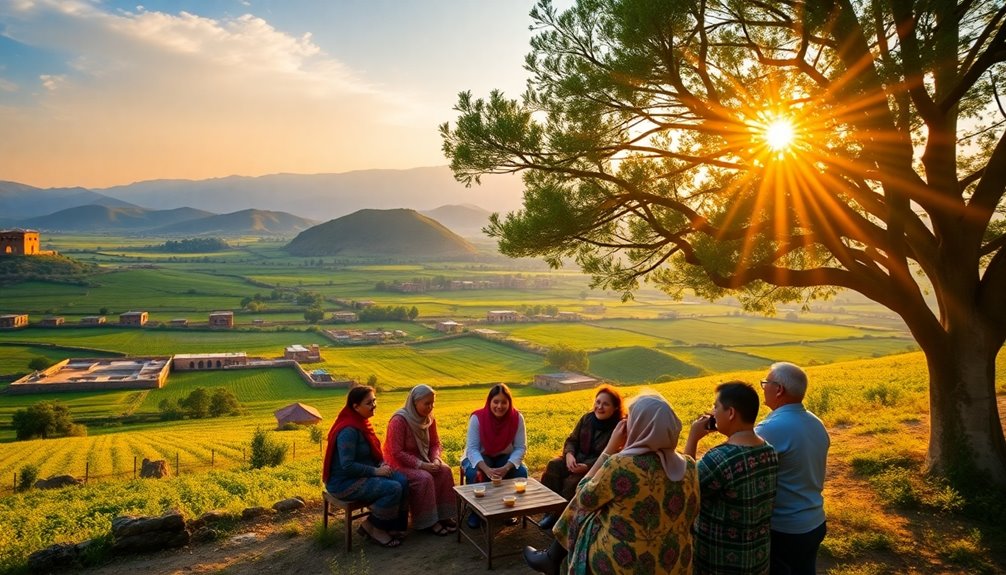
When you explore Uzbekistan's Green Tourism Route, you're stepping into a region where historic trade routes converge.
This journey not only takes you through stunning landscapes but also supports the preservation of rich cultural heritage.
Historic Trade Routes Converge Here
Uzbekistan stands as a vibrant crossroads of history, where ancient trade routes once flourished.
As a critical junction on the Silk Road, you'll discover how these paths shaped civilizations over centuries.
In Uzbekistan, you'll find:
- Influential Cities: Samarkand, Bukhara, and Khiva, which thrived as trade hubs for silk, spices, and textiles.
- Cultural Exchange: The convergence of trade routes enabled the spread of religions, philosophies, and artistic influences across Central Asia.
- Architectural Wonders: Caravanserais and bazaars that supported commerce and showcased the region's rich cultural heritage.
Cultural Heritage Preservation Benefits
The rich tapestry of Uzbekistan's history and culture isn't just a relic of the past; it thrives today through sustainable practices that protect its heritage.
By embracing eco-friendly tourism along the Green Tourism Route, you contribute to preserving the cultural heritage of UNESCO World Heritage Sites like Samarkand, Bukhara, and Khiva. This initiative encourages local communities to revive traditional crafts, such as silk weaving and pottery, ensuring these skills endure.
Your support helps fund conservation projects that maintain ancient architecture, safeguarding their historical significance. Additionally, engaging in Uzbekistan travel fosters cultural exchange, allowing locals to share their rich traditions.
As you explore, you'll also raise awareness of environmental issues, appreciating and protecting the diverse landscapes that frame this storied region.
Travel From Tashkent to Samarkand
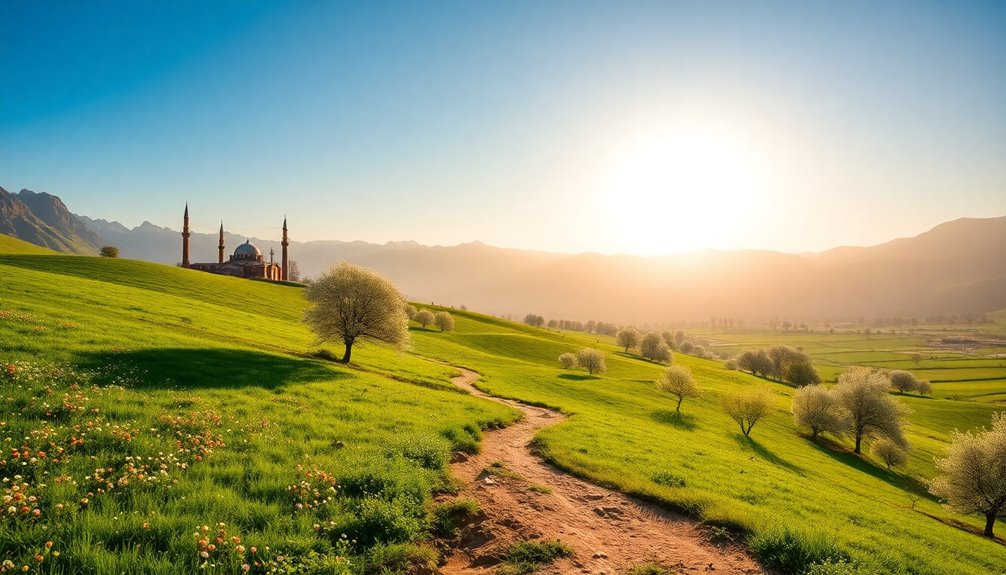
You can easily reach Tashkent with nonstop flights from major cities, including Sydney.
Once you're in Tashkent, traveling to Samarkand is a breeze, whether you choose public buses or shared taxis.
The journey not only connects you with the vibrant culture of Uzbekistan but also offers a chance to explore its historical gems along the way.
Fly Nonstop to Tashkent
Wondering how to reach the heart of Uzbekistan? Flying nonstop to Tashkent, the capital city, is your best option.
Uzbekistan Airways operates convenient flights from several major cities, making your journey easy and efficient. Once you land, you can quickly dive into the Silk Road highlights.
Here's what you can do next:
- Hop on a high-speed train, like the Afrosiyob, to Samarkand.
- Enjoy the scenic 2.5-hour ride, covering approximately 300 kilometers.
- Explore iconic sites like Registan Square and Shah-i-Zinda, all within walking distance from the train station.
With nonstop flights and quick train rides, your adventure along Uzbekistan's Green Tourism Route starts as soon as you touch down!
Direct Flights From Major Cities
How can you seamlessly travel between Tashkent and Samarkand? With direct flights available, your journey becomes quick and convenient.
Uzbekistan Airways operates regular flights, taking you from Tashkent to Samarkand in just about an hour. This efficient travel option is perfect for those exploring the historic Silk Road, connecting two of its most significant cities.
During peak tourist seasons, you'll find multiple daily departures, giving you the flexibility to choose a time that fits your itinerary. Booking your tickets is easy, whether you prefer online platforms or local travel agencies.
Fly From Sydney to Tashkent
Flying from Sydney to Tashkent opens the door to an unforgettable journey through Uzbekistan's rich history.
After your approximately 18 to 20-hour flight, you'll land in Tashkent, where modernity meets tradition.
Here's what you can look forward to:
- Explore Tashkent: Discover the capital's stunning architecture and historic sites before heading out.
- Train to Samarkand: Hop on the high-speed Afrosiyob train, which whisks you to Samarkand in just 2 hours and 30 minutes.
- Experience Samarkand: Visit iconic attractions like Registan Square and the Shah-i-Zinda necropolis, both essential stops on the Silk Road.
Your adventure through Tashkent and Samarkand promises to be a captivating exploration of Uzbekistan.
Public Buses and Shared Taxis
After soaking in the sights and sounds of Tashkent, getting to Samarkand is straightforward and affordable.
You can choose between public buses and shared taxis for your journey. Public buses run regularly, taking about 4-5 hours, with tickets costing around 25,000 UZS (about $2.50 USD).
If you're looking for a quicker option, shared taxis, known as "marshrutkas," complete the trip in just 3-4 hours for a slightly higher fare of 50,000-70,000 UZS (approximately $4.50-$6.50 USD).
Both transport options depart from the Tashkent Central Bus Station, which offers various traveler amenities.
It's wise to carry cash in Uzbek som and book your seats in advance, especially during peak tourist seasons, to ensure a smooth trip to Samarkand.
Sustainable Silk Road Experiences
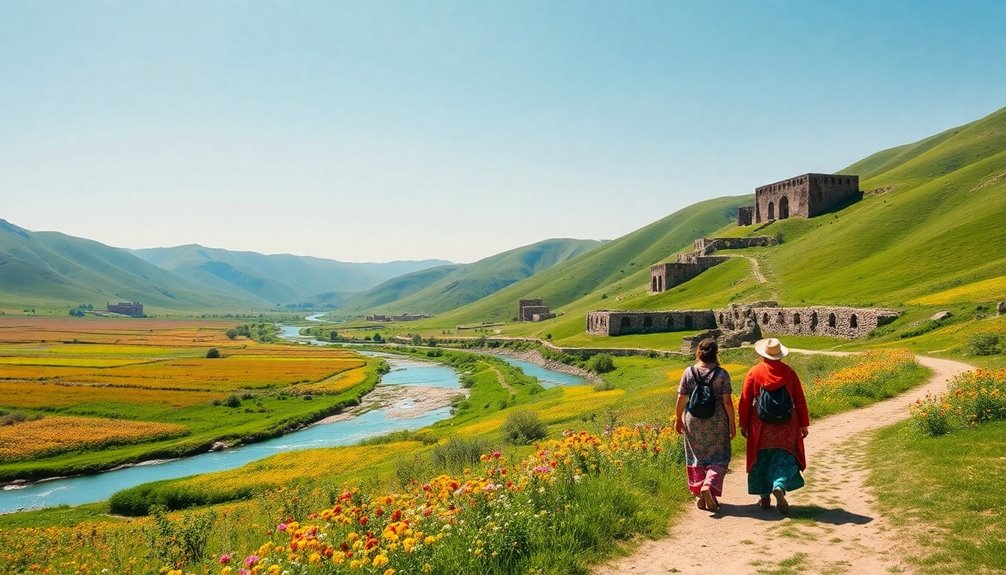
When you explore Uzbekistan's Green Tourism Route, you'll discover eco-friendly wildlife tours that connect you with the region's unique biodiversity.
You can also participate in sustainable local craft workshops, where you'll learn traditional skills while supporting local artisans.
Plus, staying in solar-powered lodging options allows you to enjoy your adventure with minimal environmental impact.
Eco-Friendly Wildlife Tours
As you embark on Uzbekistan's eco-friendly wildlife tours, you'll discover a unique blend of adventure and responsibility along the historic Silk Road.
These journeys focus on sustainable practices that protect local ecosystems and promote awareness of biodiversity. You'll engage in activities like:
- Birdwatching in stunning protected areas like the Ustyurt Nature Reserve.
- Camel trekking through the breathtaking Kyzyl Kum Desert.
- Exploring the unique flora and fauna of the Nurata mountains.
With local guides trained in sustainable practices, you'll gain valuable insights into Central Asian wildlife while ensuring your travels support conservation efforts.
These wildlife tours not only offer immersive experiences but also contribute positively to the environment and the local economy, making your adventure truly rewarding.
Sustainable Local Craft Workshops
Dive into the vibrant world of Uzbekistan's sustainable local craft workshops, where you can experience the artistry of traditional silk production firsthand.
Here, local artisans embrace sustainable practices, focusing on sericulture and silk weaving techniques like Ikat and Suzani. You'll have the chance to engage in hands-on experiences, learning the intricate art of silk weaving and embroidery while directly supporting the local economy.
These workshops use eco-friendly materials, ensuring that each handcrafted product not only reflects cultural heritage but also promotes environmental sustainability.
By participating, you foster a deeper appreciation for Uzbekistan's rich textile traditions and encourage responsible tourism.
Plus, buying directly from artisans guarantees fair compensation, helping to keep these traditional crafts alive in a globalized world.
Solar-Powered Lodging Options
Imagine staying in a charming, solar-powered lodge nestled in the Uzbek countryside, where modern sustainability meets traditional hospitality.
These eco-friendly accommodations not only reduce environmental impact but also offer you authentic experiences.
Here are three reasons to choose solar-powered lodging:
- Sustainable Tourism: You'll contribute to eco-friendly practices while enjoying your stay.
- Cultural Immersion: Experience local cuisine and traditions, enriching your travel journey.
- Comfort and Convenience: Enjoy essential amenities like lighting and heating, all powered by solar energy. Additionally, the use of energy-efficient systems ensures lower operational costs and a reduced carbon footprint.
Support Local Eco-Friendly Businesses
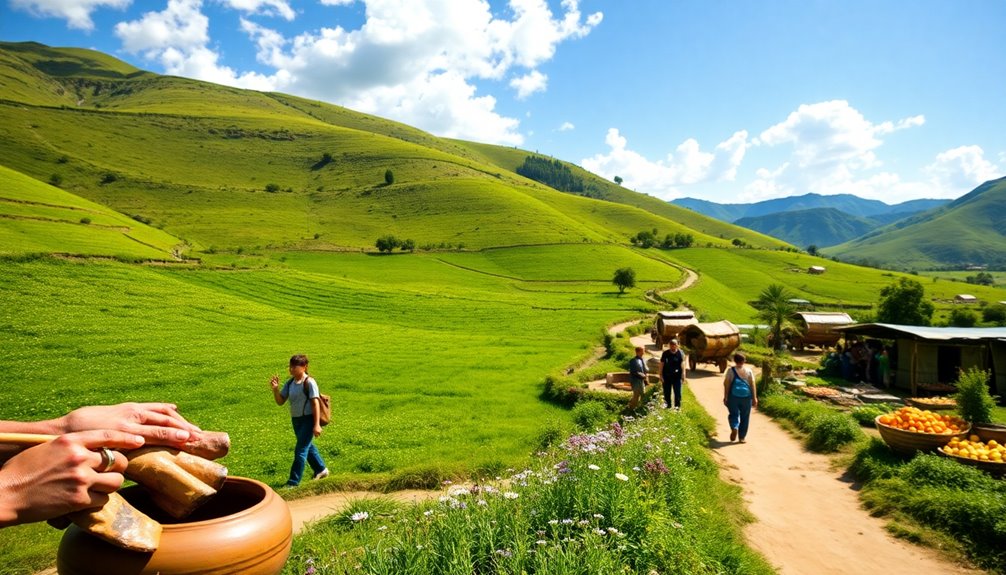
Supporting local eco-friendly businesses not only enriches your travel experience but also fosters sustainable practices that benefit the environment and local communities.
By choosing to support local eco-friendly businesses in Uzbekistan's Silk Road regions, you contribute to the preservation of traditional crafts like silk weaving and pottery, enhancing cultural heritage.
Many of these businesses utilize organic farming methods and sustainable production techniques, resulting in high-quality products with a lower environmental impact.
Staying in eco-friendly accommodations, such as guesthouses and eco-lodges, allows you to enjoy locally sourced meals and renewable energy.
Engaging with these businesses empowers rural areas, ensuring that tourism positively impacts local economies while promoting sustainable practices for future generations.
Community-Led Reforestation Projects

When you explore Uzbekistan's green tourism route, you'll notice the vibrant community-led reforestation projects in action.
These initiatives, backed by government and NGOs, not only restore natural habitats but also strengthen cultural ties and sustainable practices among locals.
Government and NGO Efforts
As Uzbekistan strives to restore its natural landscapes, community-led reforestation projects play a crucial role in reversing land degradation and enhancing biodiversity along the historic Silk Road.
The government, alongside NGOs, is making significant strides in this effort. Here's how:
- Tree Planting Initiatives: Local communities actively participate in planting native trees, which helps improve ecological balance and fight desertification.
- Agroforestry Practices: NGOs partner with farmers to implement sustainable land use practices, promoting both environmental and economic benefits.
- Education Campaigns: NGOs conduct awareness programs to empower communities, emphasizing the importance of reforestation for climate resilience and sustainable tourism.
Together, these efforts highlight the importance of community involvement in achieving a greener future for Uzbekistan.
Community and Cultural Sustainability
Community-led reforestation projects in Uzbekistan not only restore degraded landscapes but also empower local communities to thrive. By involving locals in tree planting and maintenance, these initiatives foster sustainable livelihoods and enhance eco-tourism opportunities. Over 1 million trees have been planted, improving biodiversity and supporting climate change mitigation efforts.
These projects promote environmental stewardship through education and outreach programs, engaging younger generations in conservation. Collaborations with NGOs and international agencies ensure that funding and technical support are available, reinforcing the long-term sustainability of these efforts.
Ultimately, as you explore Uzbekistan's Green Tourism Route, you'll witness how reforestation strengthens community bonds and creates a healthier environment, all while preserving the rich cultural heritage of this historic region.
Spring and Autumn Months

When you visit Uzbekistan in spring, you'll enjoy mild temperatures and stunning blooming landscapes that invite outdoor exploration.
Autumn, on the other hand, showcases vibrant colors and the excitement of harvest season, perfect for experiencing local culture.
Both seasons offer an ideal backdrop for your adventures along the Silk Road.
Mild Temperatures and Blooming Landscapes
Spring and autumn in Uzbekistan invite travelers to experience mild temperatures and stunning landscapes, making these seasons perfect for outdoor adventures along the Silk Road.
During these months, you can:
- Enjoy mild temperatures ranging from 15°C to 25°C (59°F to 77°F), perfect for exploring.
- Witness blooming landscapes filled with vibrant wildflowers in spring and colorful foliage in autumn.
- Discover the rich cultural heritage of cities like Samarkand and Bukhara without the discomfort of extreme heat.
Embracing Green Tourism during these seasons not only enhances your travel experience but also encourages sustainable practices.
As you soak in the beauty, you'll appreciate the natural wonders and cultural resources that make Uzbekistan truly unique.
Optimal Travel During Harvest Season
As harvest season unfolds in Uzbekistan, you'll find the perfect opportunity to immerse yourself in the vibrant local culture and stunning landscapes.
From September to October, you can witness the cotton and fruit harvests, including succulent grapes and melons. The local festivals, like the Grape Harvest Festival, showcase traditional music, dance, and delicious cuisine, offering you unique cultural experiences.
Spring months, particularly April to June, also present mild temperatures, making it ideal for exploring the Silk Road. Consider joining agricultural tours during these periods, where you can engage in fruit picking, visit local farms, and learn about sustainable farming practices.
Don't miss the lively autumn bazaars, brimming with fresh produce and handmade crafts that reflect Uzbekistan's rich heritage.
How to Make Your Trip More Sustainable
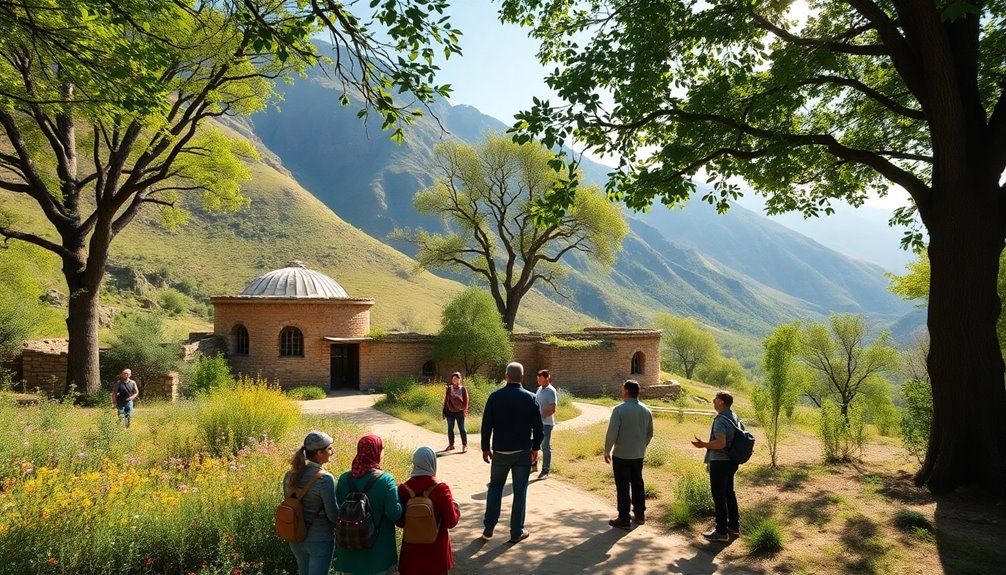
To make your trip to Uzbekistan more sustainable, start by packing reusable travel utensils to cut down on single-use plastics.
You should also seek out opportunities to support local artisans directly by purchasing their handmade crafts, which helps preserve their traditions.
These small choices can make a significant impact on the communities you visit.
Reusable Travel Utensils
While exploring the stunning landscapes and rich culture of Uzbekistan, you can make your trip more sustainable by bringing reusable travel utensils. Not only do they help reduce single-use plastic waste, but they also promote sustainable tourism practices.
Here are a few eco-friendly choices to consider:
- Stainless Steel or Bamboo Cutlery: These durable utensils can replace disposable options and often earn you discounts at local eateries.
- Collapsible Reusable Straw: Perfect for sipping beverages while minimizing plastic use.
- Lightweight Reusable Container: Ideal for taking home leftovers, supporting local food culture, and reducing waste.
Support Local Artisans Directly
Bringing reusable travel utensils is just one way to make your trip to Uzbekistan more sustainable.
To further enhance your impact, support local artisans directly by purchasing handmade souvenirs from local markets. Look for traditional crafts like Ikat textiles and Suzani embroidery, which embody Uzbekistan's cultural heritage while ensuring fair wages for the artisans.
By choosing locally made items over mass-produced goods, you contribute to sustainable tourism and help reduce the carbon footprint of imported merchandise.
Consider participating in workshops, such as silk production demonstrations in the Fergana Valley, where you can engage with artisans and learn about sustainable practices. This not only enriches your travel experience but also supports the livelihoods of artisan families in the community.
Frequently Asked Questions
Why Was Uzbekistan Important to the Silk Road?
Uzbekistan was crucial to the Silk Road because it acted as a central hub for trade and culture.
You'd find vibrant cities like Samarkand and Bukhara, where merchants exchanged goods like silk and spices. The region fostered diverse ideas and religions, shaping the cultural landscape.
Its well-constructed caravanserais ensured safe passage for travelers, allowing knowledge and commerce to flourish. This interconnectedness made Uzbekistan a vital player in the Silk Road's historical narrative.
What Famous Road Travels Through Uzbekistan?
The famous road that travels through Uzbekistan is the Silk Road.
As you explore this historic route, you'll discover how it connected Asia, the Middle East, and Europe for centuries.
You'll encounter key cities like Samarkand, Bukhara, and Khiva, each showcasing stunning Islamic architecture and rich histories.
The Silk Road isn't just a path; it's a vibrant tapestry of trade, culture, and adventure waiting for you to experience.
What Ancient City in Uzbekistan Was on the Silk Road?
You'll find that Samarkand is one of the most famous ancient cities on the Silk Road in Uzbekistan. Its rich history and vibrant culture draw travelers from all over.
As you explore, you'll see stunning architecture, bustling bazaars, and landmarks that speak to its past significance.
Bukhara and Khiva also share this heritage, offering a glimpse into the incredible trade and cultural exchanges that shaped the region along this historic route.
What Were the Three Main Routes of the Silk Road?
Have you ever wondered how ancient traders connected different cultures?
The Silk Road featured three main routes. The Northern Route ran through Central Asia, focusing on silk and textiles.
The Southern Route linked India to the Middle East, renowned for precious stones and luxury goods.
Meanwhile, the Maritime Route emerged later, facilitating trade across oceans, connecting ports in China to Africa and Europe.
Each route played a crucial role in cultural and economic exchanges.
Conclusion
As you wander through Uzbekistan's lush landscapes, let the whispers of the Silk Road guide your steps. Picture vibrant markets brimming with local crafts, the scent of fresh herbs wafting through the air, and the laughter of communities coming together for reforestation efforts. By embracing sustainable travel, you're not just exploring history; you're becoming part of a living tapestry that honors both nature and tradition. So pack your bags and dive into this green adventure—your journey awaits!

